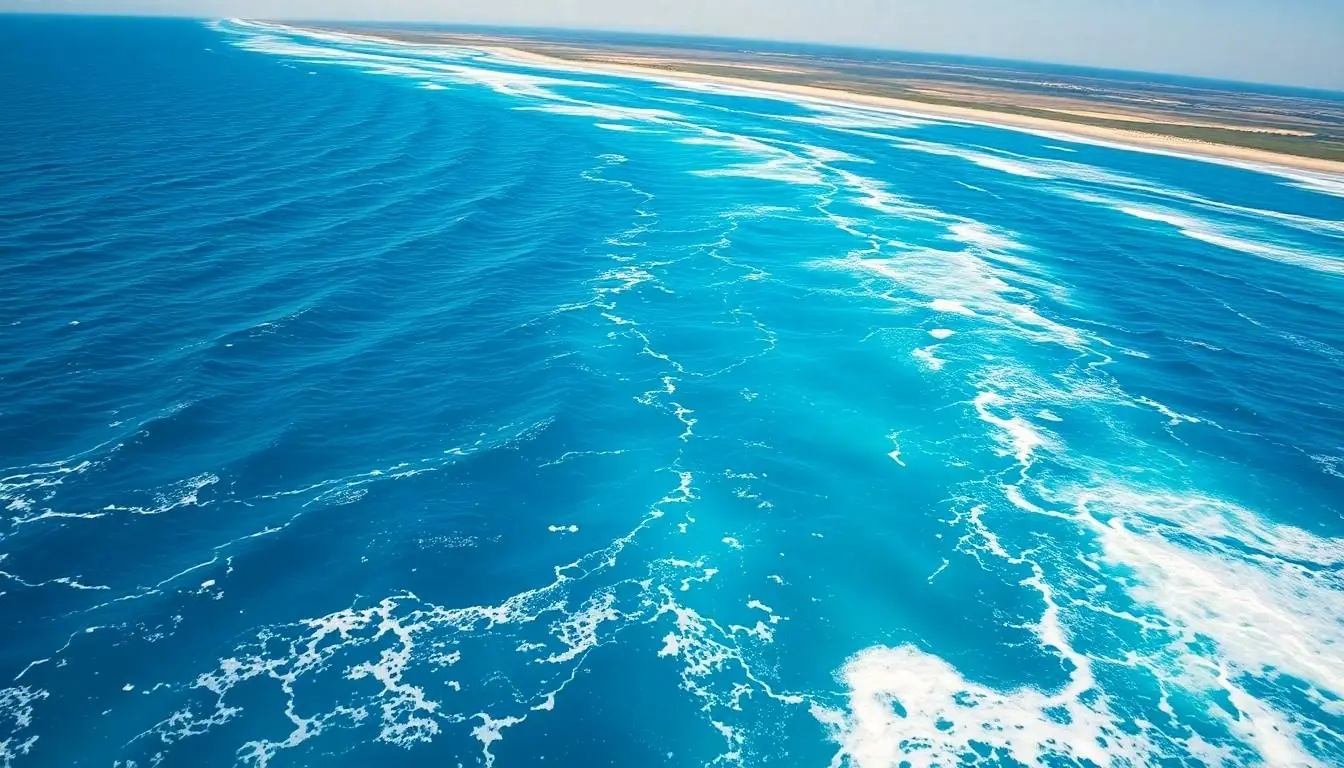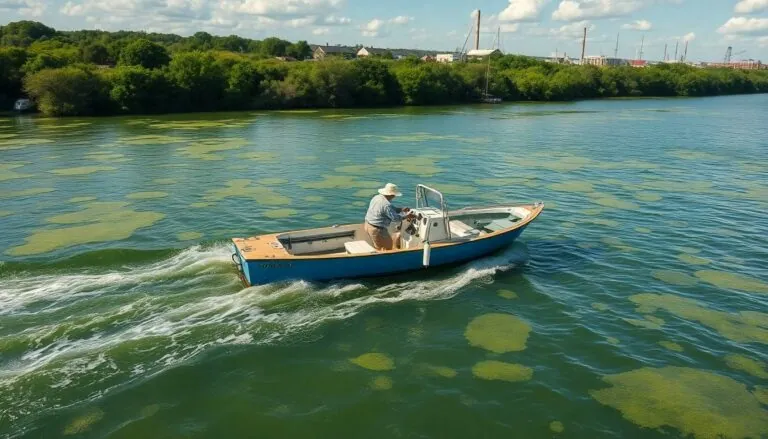The Gulf Stream isn’t just a fancy name for a tropical vacation spot; it’s a powerful ocean current that plays a crucial role in regulating our climate. But what happens when this mighty river of warm water encounters climate change? Spoiler alert: it’s not a good plot twist.
Table of Contents
ToggleOverview of the Gulf Stream
The Gulf Stream is a powerful ocean current that primarily originates in the Gulf of Mexico and flows along the eastern coast of the United States towards the North Atlantic Ocean. Its significance lies in its ability to transport warm water northward, which influences the climate in surrounding regions, particularly in Western Europe. Temperature changes caused by this current lead to milder winters in places like the United Kingdom.
Interaction with other ocean currents also plays a crucial role in maintaining global climate balance. The Gulf Stream connects with currents such as the North Atlantic Current and the Canary Current, contributing to complex ocean circulation systems. These systems help to distribute heat across the ocean and regulate weather patterns worldwide.
Changes in the Gulf Stream could result from warming sea temperatures and melting ice caps. Research indicates that the current has slowed down over the past few decades, raising significant concerns among climate scientists. A slowdown may lead to harsher winters in Europe, rising sea levels along the US coast, and altered weather patterns that can affect agricultural practices.
Oceanic and atmospheric conditions are interlinked, with fluctuations in the Gulf Stream potentially causing extreme weather events. Changes in this current’s flow might impact hurricane paths, precipitation levels, and drought occurrences. Understanding the Gulf Stream’s dynamics provides essential insights into climate change’s broader implications.
Continuous monitoring of this current is critical for predicting subsequent climate changes. Researchers employ advanced satellite technologies and ocean buoys to gather data on the Gulf Stream. Accurate forecasting relies on this information to assess potential impacts on regional climates and ecosystems.
Climate Change and Its Effects

Climate change significantly affects ocean systems, including the Gulf Stream, posing numerous challenges to climate stability.
Rising Temperatures
Rising temperatures from increased greenhouse gas emissions disrupt ocean currents. Warmer water expands, leading to a decrease in the Gulf Stream’s flow rate. A slowdown in this current may contribute to harsher winters in Europe and shifts in tropical storm patterns. Additionally, this warming can intensify heatwaves and droughts in various regions, significantly impacting agricultural production. Research shows that surface temperatures in the North Atlantic have risen by approximately 1.8°F since the 1980s, further stressing this crucial current. These changes exacerbate climate extremes, making it vital to monitor temperature fluctuations and their effects on oceanic systems.
Ocean Acidification
Ocean acidification results from increased carbon dioxide absorption by seawater. Gulf Stream systems face challenges as higher CO2 levels lower the ocean’s pH, affecting marine life. Coral reefs suffer greatly, as the decreased pH hinders calcium carbonate formation, jeopardizing biodiversity. Some studies indicate a 30% increase in acidity since the Industrial Revolution, which poses risks for shellfish and other marine organisms. Disruptions to these ecosystems lead to broader consequences for fisheries and food webs. Addressing ocean acidification requires immediate attention to carbon emissions and protection of marine environments to sustain marine biodiversity.
How Can Climate Change Impact the Gulf Stream
Climate change poses significant threats to the Gulf Stream’s stability, influencing temperature and salinity levels, altering current patterns, and impacting weather systems.
Changes in Temperature and Salinity
Rising global temperatures directly affect the Gulf Stream. Increased heat leads to warmer ocean water, which reduces the current’s ability to sink and drive circulation. Salinity changes also occur as melting ice from Greenland dilutes seawater. Freshwater influx disrupts the balance of salt and temperature, weakening the current. This combination creates a feedback loop, further amplifying climate change’s effects on the Gulf Stream. Research shows that a 20% reduction in salinity may drastically alter current dynamics.
Altered Ocean Currents and Patterns
Disruption of ocean currents results from the Gulf Stream’s slowdown. Declining flow rates can lead to significant shifts in weather patterns. Heat distribution across the Atlantic becomes uneven, causing extreme weather events. Some regions experience more intense hurricanes, while others face prolonged droughts. Studies indicate that changes in the Gulf Stream alter the paths of storms, affecting ecosystems and human populations alike. Fluctuations in precipitation patterns may impact agriculture, endangering food security.
Consequences of Gulf Stream Disruption
The disruption of the Gulf Stream significantly affects climate and weather patterns. Altered ocean currents influence temperature distributions, leading to increased weather variability. Changes in the Gulf Stream can result in more severe storms in some regions while causing extended dry spells in others. For example, areas in Western Europe might experience colder winters due to a weakened current, while the southeastern United States faces heightened hurricane risks. Research from the National Oceanic and Atmospheric Administration indicates these shifts in weather patterns play a critical role in agricultural output and biodiversity.
Sea level rise poses another serious consequence of Gulf Stream disruption. A slowdown leads to water accumulation along the U.S. East Coast, increasing the risk of flooding in coastal cities like Miami and New Orleans. In fact, projections suggest that sea levels could rise by over 6 feet by the end of the century if current trends continue. Recent studies also show that increased coastal erosion can damage infrastructure, disrupting local economies and threatening ecosystems. These impacts directly threaten human settlements and coastal habitats, requiring immediate attention and mitigation efforts.
Future Projections
Future projections indicate significant changes to the Gulf Stream due to climate change. Scientists expect increased greenhouse gas emissions to exacerbate ocean temperature increases, which can weaken current flow. Research predicts that regional climates may shift, resulting in colder winters across Western Europe while the southeastern United States faces more intense hurricane seasons.
Data shows that over the past few decades, the Gulf Stream has slowed down, with implications for sea levels along the U.S. coast. An increase in sea level by approximately 1 to 2 feet has been observed, threatening coastal cities. Experts warn that prolonged disruptions could lead to more severe weather events, including stronger storms and extended drought conditions.
Evolving salinity levels also play a critical role. As glaciers melt, freshwater influx dilutes seawater and disrupts the balance of temperature and salinity necessary for current stability. Coastal ecosystems suffer as a result, jeopardizing fisheries and biodiversity.
Models demonstrate a feedback loop in which warmer oceans exacerbate current instability. The interconnectedness of oceanic systems means that any changes in the Gulf Stream can lead to broader climatic impacts, affecting global weather patterns. Statistical analyses suggest a 40 percent decline in the flow strength could occur by 2100 if current trends persist.
Alarmingly, disrupted currents can diminish earth’s heat distribution. Regions such as the North Atlantic may experience significant temperature fluctuations, leading to adverse effects on agriculture and food security. Understanding these projections is essential for developing effective response strategies to mitigate climate change’s impact on the Gulf Stream.
The Gulf Stream’s future hangs in the balance as climate change continues to exert its influence on ocean currents. With rising temperatures and shifting salinity levels, the potential for significant disruptions grows. These changes not only threaten regional climates but also have far-reaching implications for ecosystems and economies.
Understanding the interconnectedness of ocean and atmospheric systems is crucial for anticipating the impacts of a weakened Gulf Stream. As the world grapples with the realities of climate change, prioritizing efforts to reduce greenhouse gas emissions and protect marine environments becomes essential. The health of the Gulf Stream is vital for maintaining global climate stability and ensuring the resilience of communities worldwide.





